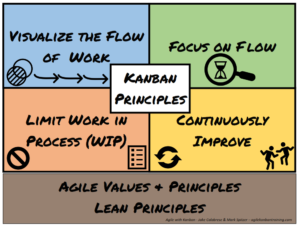Agile Kanban Training
In Agile Kanban Training, expect to learn more than just a set of practices. You will examine the difference between the agile mindset and just “doing agile,” why it matters if you want results, and learn the types of situations agile works in and why. You will explore kanban’s history and examine the essential elements of Lean (not Lean Six Sigma) and Scrum to understand how these approaches fit together.
Building on this foundation, the course walks you through Elements of an Agile-Lean Organization, from vision to continuous improvement to people. We focus on what kanban means in practice and what good practices are necessary to succeed. Throughout the course, you will use hands-on, engaging exercises to learn and expand your knowledge around:
- Manage shifting priorities and deliver quality work
- Identify where your delivery of value to your customer is slowing down or getting stuck
- Practice multiple approaches to improving the flow of value
- Create transparency to enable intentional decision making
Students in this course work on real organization processes and kanban systems. For the aspects of the class that are focused on a specific organizational process (from your organization) students will be:
- Grouped with others they work with on a regular basis to deliver products or services. These groups will select a product or service they deliver and work through the process of understanding the flow, identifying impediments, and coming up with countermeasures to those impediments.
- Grouped with others like you, if you do not have peers in attendance or tend to be individual-contributors. Each person will work on their own process, but you will exchange ideas, evaluate, and compare your work with others in your group.
An ideal class consists of groups who share responsibility for delivering some part of the same product or service. A single class can include multiple groups, addressing several products and services. This may consist of teams from IT operations, HR, sales, marketing, customer support, and other groups delivering products and services specific to your organization.
What is Kanban?
Kanban, as it’s known today, is the application of lean concepts and kanban systems to knowledge work (and interrelated task work). Kanban focuses on the value your customers want and optimizes the flow of that value to your customers.
It requires that management and employees be “all in” to make problems transparent and then to work together to solve them and continuously improve. Kanban centers on creating an environment where people can make the flow of work transparent, identify where work is getting stuck or slowing down, and focus on removing those impediments to flow. While the core concept is straightforward, it is not easy.
We explore common challenges and tips for success throughout the course!

This course is designed for anyone who
- Wants the benefits of agile but operates in an environment where the work is not predictable enough for sprints or iterations
- Is looking to apply agile outside of software in a clear and practical way
- Wants better ways to work together and remove bottlenecks from their work
- Works with others to deliver products and services and is looking for ways to communicate more clearly and effectively
Learning Objectives
- Identify the types of situations agile adds value to and why
- Examine what “being agile” vs. “doing agile” means in practice
- Discuss agile values and principles and their impact on your organization
- Compare kanban and Scrum – another agile approach – in order to work with teams who are using Scrum
- Define Lean principles and kanban values that support collaboration and performance
- Discover how to identify and tackle impediments to flow with the Theory of Constraints
- Practice techniques to continuously improve
- Examine how the foundations of an Agile-Lean Business apply to your organization
- Identify the core elements of kanban and their practical application in teams and organizations
- Practice designing a kanban system (including kanban boards and cards) to gain valuable insights and optimize outcomes
- Observe how planning and forecasting work in kanban systems
- Understand metrics and charts that can help you assess performance and identify improvements
- Explain how kanban can be used to identify and make the case to remove organizational constraints
Who Should Attend
Kanban is often used by people working outside of IT, throughout the organization as well as in IT outside of software. As such, this course should be attended by:
- R&D, Operations, IT Support, DevOps
- Sales, Marketing, Customer Support
- Manufacturing, Distribution
- Human Resources, Purchasing, Accounting, Finance, Facilities
- Anyone who works with others and wants to engage with other people to continuously improve!
What to Expect
We take training and learning seriously. We respect the investment of both time and money that you are making to advance your skills. As such, we use the latest training approaches and techniques. We also bring energy and fun to ensure you have the best possible experience and learn as much as possible. In this course, you can expect:
- Brain-friendly training to dramatically increase learning and retention (instructors are Certified Training From the Back of the Room Trainers).
- Opportunities throughout the course to focus on your real-world situations.
- In-depth engagement with your instructors and fellow attendees. If you are looking for a dry lecture (we use zero slides), this class is NOT for you!
- Interactive, fun, and experiential learning — increasing safety and retention — laughing helps learning.
- Challenging work with others that focuses on your real organizational issues.
Virtual Training:
- Our training is currently happening virtually in most cases. We use extremely interactive tools, learning canvases, and methods to boost the fun and learning. If you are looking for in-person training at your location, please contact us to discuss options.
- We have specifically designed all of our training for live-instructor, virtually led classes. We know there are (still) virtual training skeptics. Some have tried virtual training and just watched piles of videos or listened as people clicked through slides (we never use slides).
- We work through in-depth and fun (really) exercises throughout the course in small groups.
- But don’t just take our word for it – we are 100% glad to take you through a live lesson and show you how we teach. If it works for you, great! We can see about moving forward. If not, we can point you to someone that is a better fit based on your needs – no joke!
- Additionally, we send every student (direct to their home or shipping location) a color, in-depth course workbook and materials. We considered just sending some electronic files, but we have had way too many students reach out to thank us for something “real” in a virtual world.
Details
Length & Level
- Length: 2-Days
- Level: Beginner to Intermediate – this course scales based on students’ experience.
Course Credit
- 16 PMI PDUs
- 16 Scrum Alliance SEUs
Prerequisites
- Anyone interested in learning these practices and ideas with a mindset open to new concepts (skeptical is still okay – as long as you are open).
- Pre-reading/Pre-work will be sent out to allow everyone attending to start with some basic information about agile.
Contact Us or Sign up for a Public Class
Contact us to set up a time to answer your questions or to see a sample of how our virtual training works! Or feel free to download a PDF of the Course Brochure to review or share with someone.

